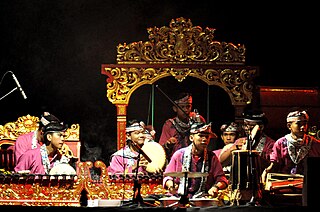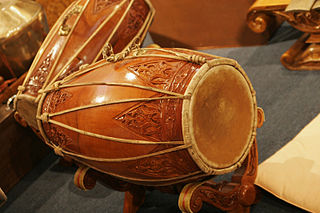Related Research Articles

Gamelan is the traditional ensemble music of the Javanese, Sundanese, and Balinese peoples of Indonesia, made up predominantly of percussive instruments. The most common instruments used are metallophones played by mallets and a set of hand-played drums called kendhang/Kendang, which register the beat. The kemanak and gangsa are commonly used gamelan instruments in Bali. Other instruments include xylophones, bamboo flutes, a bowed instrument called a rebab, a zither-like instrument siter and vocalists named sindhen (female) or gerong (male).

Gamelan gong kebyar is a style or genre of Balinese gamelan music of Indonesia. Kebyar means "to flare up or burst open", and refers to the explosive changes in tempo and dynamics characteristic of the style.

Kotekan is a style of playing fast interlocking parts in most varieties of Balinese Gamelan music, including Gamelan gong kebyar, Gamelan angklung, Gamelan jegog and others.

A gamelan gadhon is an ensemble consisting of the 'soft' instruments of the Javanese gamelan. This can include rebab, gendér, gendér panerus, voice, slenthem, suling, siter, gong, kempul, kenong and kendhang.

Gamelan beleganjur is one of the most popular styles of gamelan music in Bali. Its closest Western analogue is probably the Western military band.

The gong ageng is an Indonesian musical instrument used in the Javanese gamelan. It is the largest of the bronze gongs in the Javanese and Balinese gamelan orchestra and the only large gong that is called gong in Javanese. Unlike the more famous Chinese or Turkish tam-tams, Indonesian gongs have fixed, focused pitch, and are dissimilar to the familiar crash cymbal sound. It is circular, with a conical, tapering base of diameter smaller than gong face, with a protruding polished boss where it is struck by a padded mallet. Gongs with diameter as large as 135 centimeters have been created in the past, but gongs larger than about 80 centimeters are more common especially to suit the budget of educational institutions.

Kendang or Gendang is a two-headed drum used by people from the Indonesian Archipelago. Kendang is one of the primary instruments used in the Gamelan ensembles of Javanese, Sundanese, and Balinese, the Kendang ensemble as well as various Kulintang ensembles in Indonesia, Brunei, Malaysia, Singapore, and the Philippines. It is constructed in a variety of ways by different ethnic groups. It is a relation to the Indian mridangam double-headed drum.

The kempyang and ketuk are two instruments in the gamelan ensemble of Indonesia, generally played by the same player, and sometimes played by the same player as the kenong. They are important beat-keepers in the colotomic structure of the gamelan. Depending on the structure, they play different, repeating patterns every gongan. Not all structures use the kempyang, but the kempyang is never played without the ketuk.
The slentho is a musical instrument of the gamelan. It is similar to the saron family of instruments, and would be its lowest member. Like those instruments, it has (typically) seven keys in the same arrangement, over a resonator box, and is hit with a wooden mallet (tabuh). However, unlike the other sarons, the center of its keys have a boss similar to that of a bonang. The slentho usually has the same notes as the slenthem, but a brighter, louder sound.

The Kenong is a musical instrument of Indonesia used in the gamelan. It is a kind of gong and is placed on its side. It has the same length and width. Thus, it is similar to the bonang, kempyang, and ketuk, which are also cradled gongs. Kenongs are generally much larger than the aforementioned instruments. However, the kenong has a considerably higher pitch. Its sound stands out because of its unique timbre. The kenong sticks are taller than that of the bonang. The kenong is sometimes played by the same player as the kempyang and ketuk.

Colotomy is an Indonesian description of the rhythmic and metric patterns of gamelan music. It refers to the use of specific instruments to mark off nested time intervals, or the process of dividing rhythmic time into such nested cycles. In the gamelan, this is usually done by gongs of various size: the kempyang, ketuk, kempul, kenong, gong suwukan, and gong ageng. The fast-playing instruments, kempyang and ketuk, keep a regular beat. The larger gongs group together these hits into larger groupings, playing once per each grouping. The largest gong, the gong ageng, represents the largest time cycle and generally indicates that that section will be repeated, or the piece will move on to a new section.
Pathet is an organizing concept in central Javanese gamelan music in Indonesia. It is a system of tonal hierarchies in which some notes are emphasized more than others. The word means '"to damp, or to restrain from" in Javanese. Pathet is "a limitation on the player's choice of variation, so that while in one pathet a certain note may be prominent, in another it must be avoided, or used only for special effect. Awareness of such limitations, and exploration of variation within them reflects a basic philosophical aim of gamelan music, and indeed all art in central Java, namely, the restraint and refinement of one's own behaviour." Javanese often give poetic explanations of pathet, such as "Pathet is the couch or bed of a melody." In essence, a pathet indicates which notes are stressed in the melody, especially at the end of phrases (seleh), as well as determines which elaborations are appropriate. In many cases, however, pieces are seen as in a mixture of pathets, and the reality is often more complicated than the generalizations indicated here, and depend on the particular composition and style.
The ompak or umpak ("bridge") is a section of a gamelan composition.
The merong is a section of a composition for Javanese gamelan, a musical ensemble featuring metallophones, xylophones, drums, and gongs. Specifically, the merong is the initial part of a gendhing. A merong cannot be played on its own, but must be followed by a minggah, which may also take the form of a ladrang or other colotomic structure.
Lik or Ngelik is a part of an Indonesian gamelan composition that contrasts from the surrounding section, either the ompak or merong.
The minggah or inggah is a section of a gendhing composition for gamelan.
A gatra is a unit of melody in Indonesian Javanese gamelan music, analogous to a measure in Western music. It is often considered the smallest unit of a gamelan composition.

The bedhaya is a sacred, ritualised Javanese dance of Java, Indonesia, associated with the royal palaces of Yogyakarta and Surakarta. Along with the srimpi, the bedhaya epitomized the elegant character of the royal court and became an important symbol of the ruler's power.
Javanese poetry is traditionally recited in song form. The standard forms are divided into three types, sekar ageng, sekar madya, and sekar macapat, also common with the ngoko terms: tembang gedhé, tembang tengahan, and tembang macapat. All three types follow strict rules of poetic construction. These forms are highly influential in Javanese gamelan.

Mangkunegara IV (1811–1881) was the fourth ruler of Mangkunegaran, a principality based in Surakarta, Java, ruling from 1853 to 1881. He was son-in-law of Mangkunegara III. His title before ascending was Prince Adipati Prangwedana III.
References
- Neil Sorrell. A Guide to the Gamelan. London: Faber and Faber, 1990. Page 80.